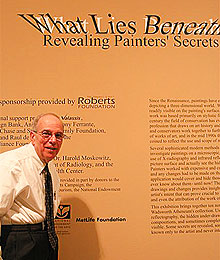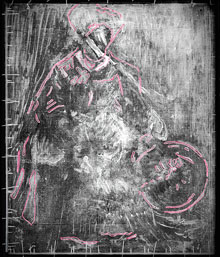  |
| HOME | THIS ISSUE | CALENDAR | GRANTS | BACK ISSUES | < BACK | NEXT > |
Radiologist's work helps museums uncover paintings' secretsby Kristina Goodnough - February 9, 2009
|
||||
| It’s unlikely the brooding stare in van Gogh’s “Self-Portrait” reflects a premonition of nasty rumors that would circulate about the work nearly a century after his death. More likely, the artist was simply experimenting with expression and technique.
Luckily for the Wadsworth Atheneum, which owns the painting, the staring face covers a shadowy figure of a woman museum officials believe van Gogh painted on the canvas before he used it for his self-portrait. The similarity of that figure to peasants and country scenes painted by van Gogh between 1882 and 1885 in Nuenen, the Netherlands, helps squelch charges of forgery that were leveled against the painting in the late 1980’s. The figure was uncovered with an X-ray 20 years ago by Health Center radiologist Dr. Harold Moskowitz, when he was director of radiology at Mount Sinai Hospital in Hartford. The painting is now part of an exhibition at the Atheneum, What Lies Beneath: Revealing Painters’ Secrets, that displays what the Atheneum calls a fairly common phenomenon: under-images of paintings. Moskowitz says the opportunity to take an X-ray of the painting came along by chance: “I met the museum’s chief conservator, Stephen Kornhauser, at a gathering, and he said the museum could use my help. He wanted me to X-ray the painting because of charges by a famous art critic that it was a forgery.” The painting was brought to the hospital, where it was carefully X-rayed. When the film was hung on the view box, Moskowitz says, “at first we didn’t know what we were looking at. Then we turned it around and there was a rush of excitement as museum experts recognized the Nuenen figure.”
The under-image helped authenticate the painting, says Moskowitz. That was important for the museum, since the painting is a special part of the Atheneum’s holdings. Since then, he has helped the Atheneum and other museums examine other pictures, generally using X-ray equipment owned by the museums for the purpose. X-rays penetrate objects depending on the energy level of the X-ray beam. The image created on a piece of film depends on the density of the material, as well as the atomic number of the structures involved, says Moskowitz. Material with a high atomic number, or a high density, absorbs more of the X-ray beam, which will show on the film as a white area. Structures with less density, or a lower atomic number, permit more of the X-rays to strike the film, producing an area that is black. “Because of its unique characteristics, X-ray can differentiate the different elements of a painting from support, canvas, paint, and varnish,” says Moskowitz. “A radiogram will reveal not only how a picture was built, but also whether its dimensions have been tampered with. It provides information that can be very helpful to conservators and restorers.” The exhibition is on display at the Atheneum through the end of March. |
| ADVANCE HOME UCONN HOME |


